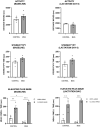Effects of maternal social isolation on adult rodent offspring cognition
- PMID: 37173349
- PMCID: PMC10177704
- DOI: 10.1038/s41598-023-34834-0
Effects of maternal social isolation on adult rodent offspring cognition
Abstract
Prenatal experiences can influence offspring physiology and behaviour through the lifespan. Various forms of prenatal stress impair adult learning and memory function and can lead to increased occurrence of anxiety and depression. Clinical work suggests that prenatal stress and maternal depression lead to similar outcomes in children and adolescents, however the long-term effects of maternal depression are less established, particularly in well controlled animal models. Social isolation is common in depressed individuals and during the recent COVID-19 pandemic. Accordingly, for this study we were interested in the effects of maternal stress induced via social isolation on adult offspring cognitive functions including spatial, stimulus-response, and emotional learning and memory that are mediated by different networks centered on the hippocampus, dorsal striatum, and amygdala, respectively. Tasks included a discriminative contextual fear conditioning task and cue-place water task. Pregnant dams in the social isolation group were single housed prior to and throughout gestation. Once offspring reached adulthood the male offspring were trained on a contextual fear conditioning task in which rats were trained to associate one of two contexts with an aversive stimulus and the opposing context remained neutral. Afterwards a cue-place water task was performed during which they were required to navigate to both a visible and invisible platform. Fear conditioning results revealed that the adult offspring of socially isolated mothers, but not controls, were impaired in associating a specific context with a fear-inducing stimulus as assessed by conditioned freezing and avoidance. Results from the water task indicate that adult offspring of mothers that were socially isolated showed place learning deficits but not stimulus-response habit learning on the same task. These cognitive impairments, in the offspring of socially isolated dams, occurred in the absence of maternal elevated stress hormone levels, anxiety, or altered mothering. Some evidence suggested that maternal blood-glucose levels were altered particularly during gestation. Our results provide further support for the idea that learning and memory networks, centered on the amygdala and hippocampus are particularly susceptible to the negative impacts of maternal social isolation and these effects can occur without elevated glucocorticoid levels associated with other forms of prenatal stress.
© 2023. The Author(s).
Conflict of interest statement
The authors declare no competing interests.
Figures










References
Publication types
MeSH terms
Grants and funding
LinkOut - more resources
Full Text Sources
Medical

